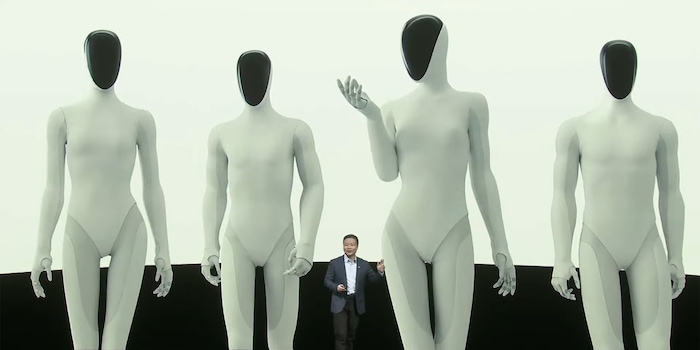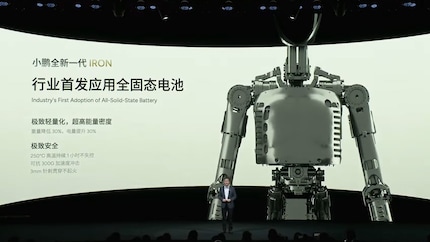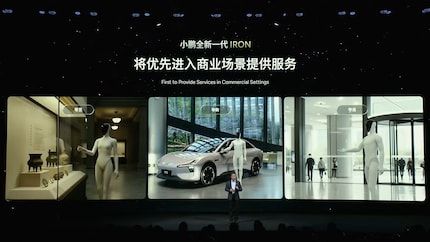
Chinese company Xpeng brings Asimov robots into mass production
The Chinese tech company Xpeng presents the Iron robot, which stands out with its human-like aesthetics and movement. The company plans to produce the robot in large numbers from 2026.
At AI Day in Guangzhou, the in-house product show organised by technology company Xpeng, CEO He Xiaopeng presented the second generation of the Iron robot. There is now a lot of news about new robots. Iron stands out from the crowd not because of the new tricks that the robot has been trained to perform, but because it aims to look and move as human-like as possible.

Source: Xpeng Keynote
In his keynote speech, He Xiaopeng had an Iron robot with a female physique march onto the stage. Or rather prancing: the robot's gait is modelled on that of models on the catwalk, but still seems a little jerky. Iron appears to be wearing a tight-fitting full-body suit and actually has the proportions of a slim woman. Instead of a face, however, the robot has a rounded display on which diffuse colour gradients can be seen.
Robots should look as human as possible
He Xiaopeng then explains the company's strategy. In the future, he sees robots as colleagues and service personnel in public life. For robots to be accepted by people, they need to look as familiar as possible - and therefore human.
According to the CEO, the internal structure of the robot is strongly modelled on the human bone and musculoskeletal system. This should enable the Iron to imitate human movements very well, such as shrugging its shoulders, bending over or lying down. «We don't make robots, we make people», says He Xiaopeng.
The hands must also be able to function as precisely as possible. Xpeng says he has spent a long time working on making sure that Iron can use its hands like a human. Each robot hand should have 22 degrees of freedom to imitate the various finger movements. This should enable Iron to grasp very small objects. The development team also emphasises a quiet gait. The display on the head is intended to show facial expressions and emotions.

Source: Xpeng Keynote
The company wants to achieve further human resemblance through different body shapes and proportions. According to He Xiaopeng, «as with the configuration of a car» further personalisation is possible: the robot body should have male or female proportions and also present itself as more athletic or fuller.
In the future, different hairstyles and clothing styles could also be available. This is reminiscent of a story by robot visionary Isaac Asimov, where designing fashionable robot clothing is a regular profession. The Iron is currently wearing his Adam costume: a synthetic skin made of white fabric.

Source: Xpeng Keynote
Four instead of three robot laws
When it comes to human-like robots, science fiction fans also quickly think of Asimov. The author and scientist formulated the famous three laws of robotics back in the first half of the 20th century. In his stories, they form the basis for the interaction between robots and humans and are still frequently quoted today.
So also from He Xiaopeng. He states that Iron must adhere to the three robot laws. His company has also added a fourth principle to the rules, which is aimed at data protection: The robot must not disclose any private data of a human. This principle is necessary because the robot is fully integrated into its environment and sees and hears everything that goes on around it.
Iron should not only look human, however, but also be able to move autonomously in its environment and react to it. According to He Xiaopeng, AI models that the company has developed for its cars will also be used for this purpose. The robot is said to have a computing power of 2250 TOPS (2250 trillion operations per second), which, according to the CEO, makes the Iron the most powerful robot currently available.
Application and mass production
According to He Xiaopeng, the Iron's human-like appearance and high data processing capabilities mean that it can theoretically also be used in the home. However, he prioritises commercial use, for example as a tour guide, shopping assistant or at reception desks. At Xpeng, Iron will be guiding visitors through the car showroom and presenting the vehicles from next year onwards.
In his keynote speech, He Xiaopeng states that the Iron will go into mass production from 2026.

Source: Xpeng Keynote
Feels just as comfortable in front of a gaming PC as she does in a hammock in the garden. Likes the Roman Empire, container ships and science fiction books. Focuses mostly on unearthing news stories about IT and smart products.
From the latest iPhone to the return of 80s fashion. The editorial team will help you make sense of it all.
Show all